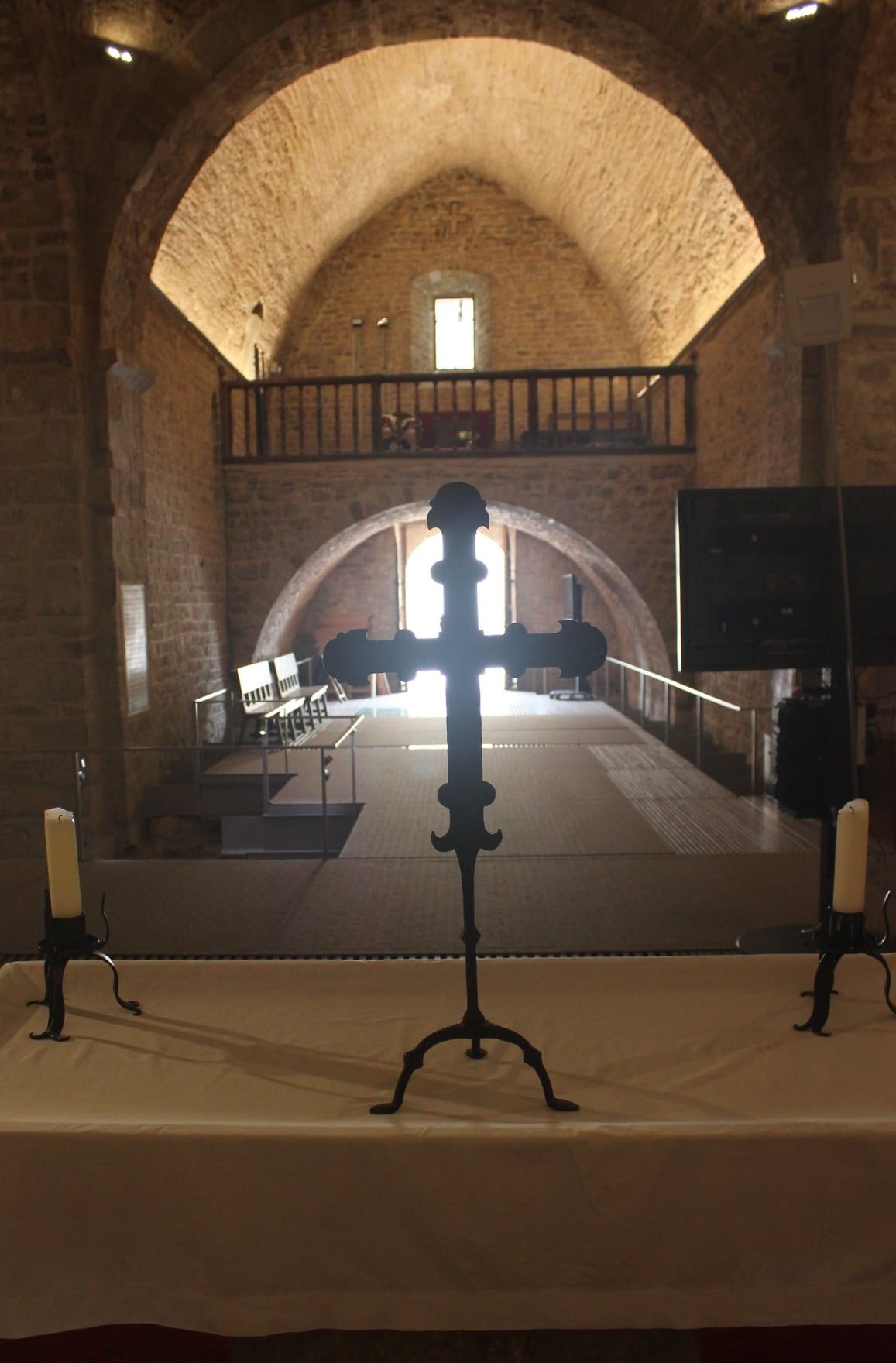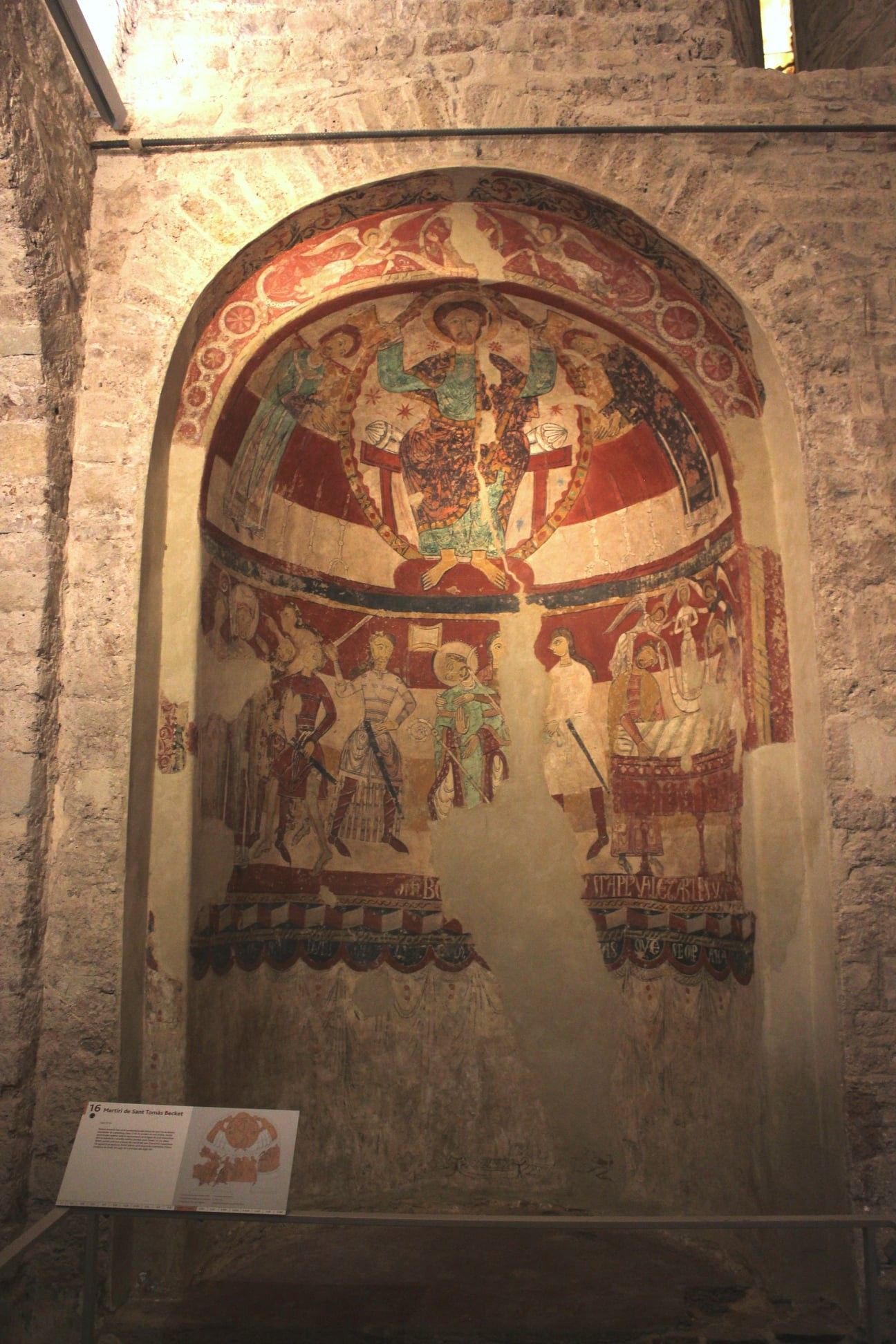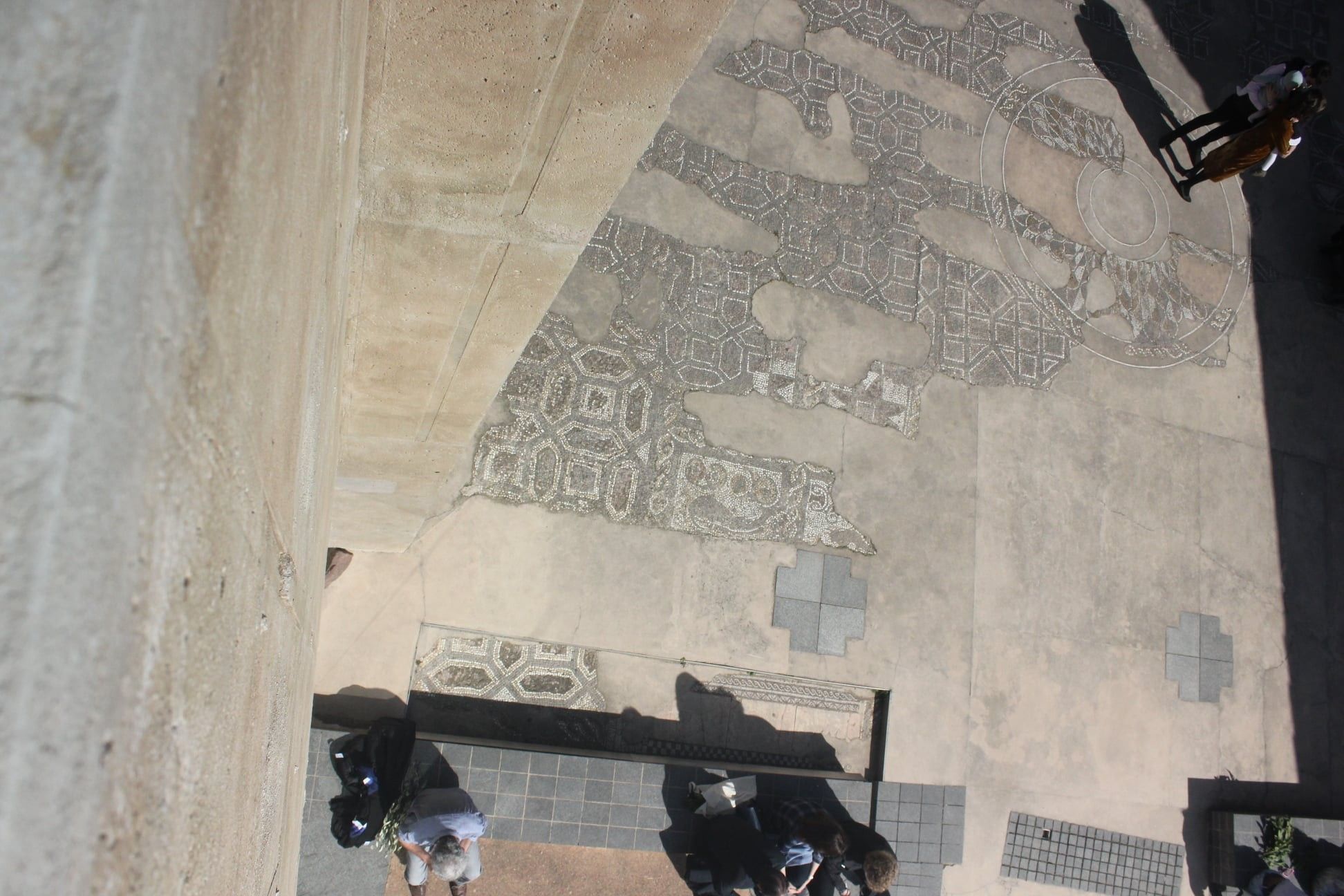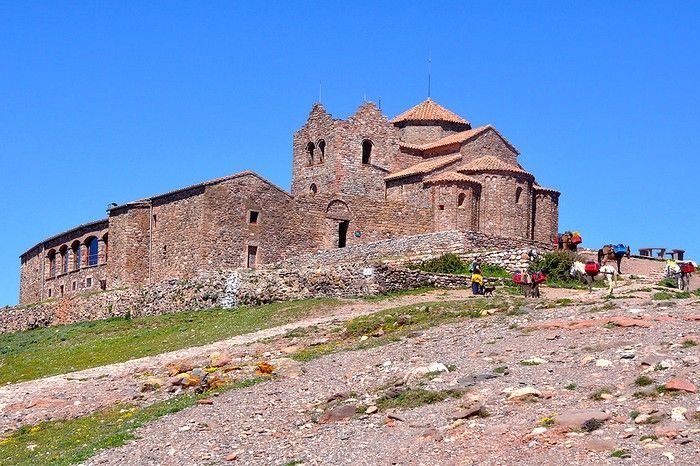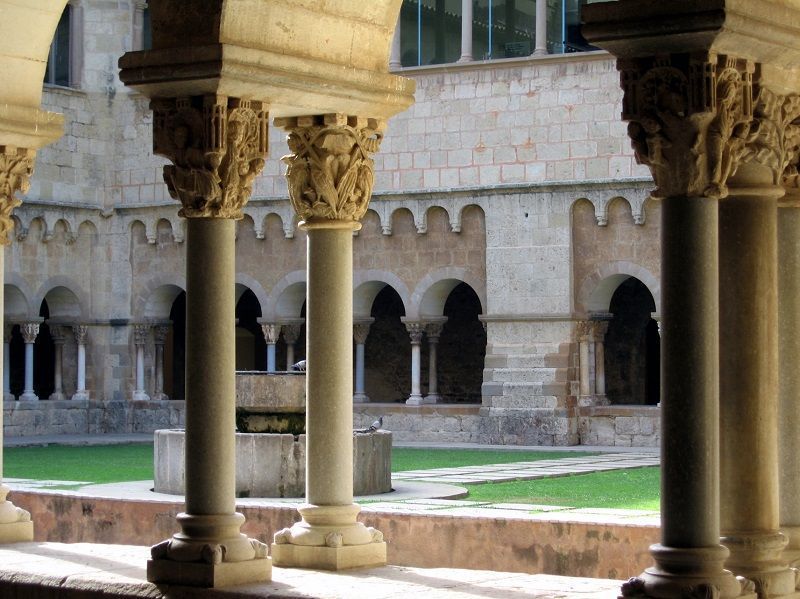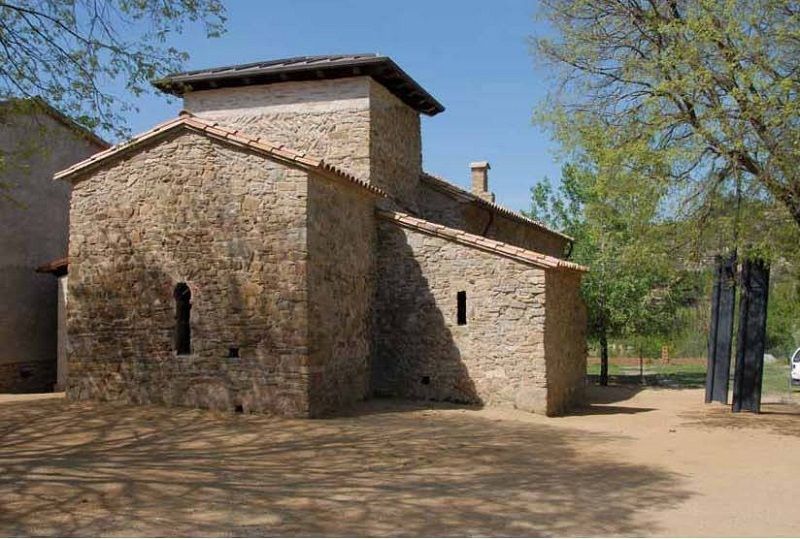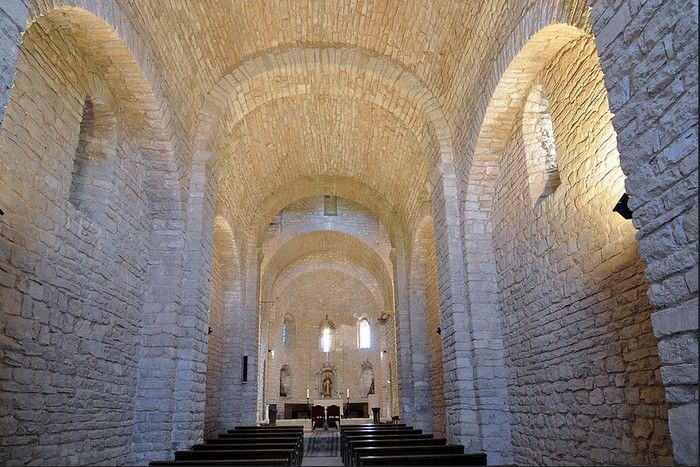SANTA MARÍA DE TARRASA

Thanks:
To Christiane Maquet Dujardin who has provided us with the current photos that we include in the gallery.
Previous notes
- The complete Episcopal Ensemble of Tarrasa was declared National Monument in 1931and Artistic and Historical World Heritage site in 1985.
- Formed by three buildings, the Santa María cathedral, to the south of the ensemble; the baptistry and the parochial church.
- It has gone under several restoration processes along the 20th century and from the year 2000 through 2008 a complete Direc tor Plan of the Monumental Emsemble that included study, restoration and revaluation.
Description
(See first the general description of the Episcopal Ensemble of Terrassa)
Considered as the cathedral church within the Episcopal Ensemble. It is the building at the south end that has survived 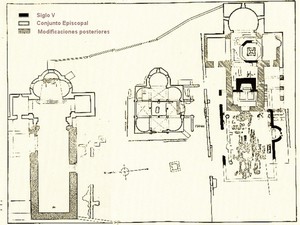 very much modified with regard to what is supposed was its original structure. It was built largely upon the previous basilic and paractically upon the same axis but enlarged to the east so that the basilic and the baptistry of the 5th century had been left within. Originally it was a three nave basilic of 18.5m long. Its northern side reached probably the church of San Miguel, with one door to communicate between them. It had one only apse, still preserved, of square plan externally and very pronounced horse shoe arch shaped internally, very similar to those of San Fructuoso de Montelios, Santa María de Melque and later in several Mozarabic churches like San Cebrián de Mazote, Santiago de
very much modified with regard to what is supposed was its original structure. It was built largely upon the previous basilic and paractically upon the same axis but enlarged to the east so that the basilic and the baptistry of the 5th century had been left within. Originally it was a three nave basilic of 18.5m long. Its northern side reached probably the church of San Miguel, with one door to communicate between them. It had one only apse, still preserved, of square plan externally and very pronounced horse shoe arch shaped internally, very similar to those of San Fructuoso de Montelios, Santa María de Melque and later in several Mozarabic churches like San Cebrián de Mazote, Santiago de 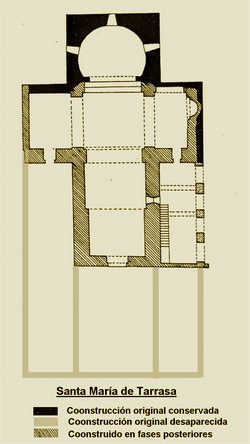 Peñalva and even San Miguel de Escalada, although all of them had an apse for each nave in the chevet, whereas in this case there were three naves and one only apse. The access arch to the apse of the central nave, the only one that exists today, although rebuilt, is also horse shoe shaped upon imposts that would have leaned upon columns and capitals that today have been replaced by a poor quality filler in the lateral walls up to the end of the imposts.
Peñalva and even San Miguel de Escalada, although all of them had an apse for each nave in the chevet, whereas in this case there were three naves and one only apse. The access arch to the apse of the central nave, the only one that exists today, although rebuilt, is also horse shoe shaped upon imposts that would have leaned upon columns and capitals that today have been replaced by a poor quality filler in the lateral walls up to the end of the imposts.
From its initial construction, only the apse an part of the first stretch of the naves still remain. The disappearance of the two lateral ones left a sort of a crossing in front of the present nave that corresponds to the central one of the original basilic, although shorter because the two lateral naves have disappeared, what generates in the present church a plan with the shape of a Latin cross, very different to what must have been its original appearance. Besides this nave, in the reconstruction of beginnings of the 12th century the present crossing was completed and a dome was added upon its intersection with it, that supports a bell tower, all Lombard type.
As in everything preserved of the initial construction in the other two churches; the kind of bond is very regular, based on small ashlars sometimes  alternated with bricks and using larger stones in the corners and in some cases, probably reutilized, well squared ashlars. In the sanctuary a triangular pediment of the same kind can be seen, but with stones of a different colour. The only covering preserved from this phase is the apse’s, that is vaulted dome shaped. Two Roman amphoras showed up inside. The covering is two pitched, flat tiles interspersed with curved ones. Covering the whole apse’s dome, a set of pictorial decoration can be seen., distributed in concentric circles, similar to those of the dome of Centelles, but with religious motifs that recall the Mozarabic miniature and that, from our point of view, would belong to the 10th or beginnings of the 11th centuries, although several authors consider it is from the 9th century.
alternated with bricks and using larger stones in the corners and in some cases, probably reutilized, well squared ashlars. In the sanctuary a triangular pediment of the same kind can be seen, but with stones of a different colour. The only covering preserved from this phase is the apse’s, that is vaulted dome shaped. Two Roman amphoras showed up inside. The covering is two pitched, flat tiles interspersed with curved ones. Covering the whole apse’s dome, a set of pictorial decoration can be seen., distributed in concentric circles, similar to those of the dome of Centelles, but with religious motifs that recall the Mozarabic miniature and that, from our point of view, would belong to the 10th or beginnings of the 11th centuries, although several authors consider it is from the 9th century.
Conclusions
The doubts about the building date of the basilic are generated because, all the structural features, with the apse’s plan, the access arch and the horse shoe shaped widows, and a kind of vault that  already existed in Spain since the Roman period, lead us to place it in the Visigothic or in the Mozarabic periods, we find that the kind of bond used, although also known since Roman times, recall more the Carolingian art, relating it, for example, with Germiny-des Prés. In principle it is clear that they seem two contradictory features that compel a very complete analysis from the artistic as well as from the historical point of view, in which we find several circumstances worth bearing in mind:
already existed in Spain since the Roman period, lead us to place it in the Visigothic or in the Mozarabic periods, we find that the kind of bond used, although also known since Roman times, recall more the Carolingian art, relating it, for example, with Germiny-des Prés. In principle it is clear that they seem two contradictory features that compel a very complete analysis from the artistic as well as from the historical point of view, in which we find several circumstances worth bearing in mind:
- Germiny was built by the Visigoth Teodulfo, emigrated from Spain, who became, under the name of Píndaro, one of the most influential characters in the kingdom of Charlemagne (768-814) and bishop of Orleans, and it is generally accepted that the design of that church is clearly inspired in Visigothic art. Therefore, it is also acceptable the idea of a possible influence from Visigothic churches, like the Terrassa churches, in this kind of Carolingian constructions. We shall study this subject with more detail on analysing San Miguel.
- The fact that in Terrassa, part of the preserved arches have a horse shoe shape and in most of them as structural elements, takes us to a Visigothic
 period dating – 7th century- or Mozarabic -end of the 9th or 10th centuries-.
period dating – 7th century- or Mozarabic -end of the 9th or 10th centuries-. - It is important to take into consideration that it seems reasonable that an episcopal ensemble of this importance Cabeza de Griego were built lon the bishopry’speak moment, and therefore with plenty of economic resources, what took place in the second half of the 7th century. Another reason to support this dating is that in Visigothic times it was usual to raise important buildings in episcopal sees in big cities like Toledo, Mérida, Córdoba, Évora, Barcelona and even the great basilic of that, although located in a bishopry of much lesser importance than the mentioned ones, is the largest building in Spanish Pre Romanesque art which measurements we know. However, in the Mozarabic phase, the building effort was targeted mainly to the creation of monasteries in rural areas.
- From our point of view there is another important element to consider. It has to do with the great diffrences in the design of the three churches of Terrassa. In our introduction, the Visigothic and the Mozarabic art, that we consider as Neovisigothic, we have reached the conclusion that the main features of these two phases, different to the Asturian art, much more normalized, are, on the one hand, their capacity to assimilate all the influences found in Spain as well as the new ones that were coming and, on the other hand, for its eclecticism, that let them build without a defined norm and utilizing in each case the structures and the building techniques known at that moment without any previous conditionings. For that reason it is impossible to find general rules nor in the shape of the buildings nor in the technical solutions and neither in the kind of bond utilized. From that point of view, all the Episcopal Ensemble of Tarrasa, with its different structures, its distinct apses but following models of the three types prior to the 8th century, its horse shoe arches and the utilization of an unusual bond, but that could have precedents from the Roman or Early Christian periods in the area, is a clear example of the characteristics we find in the last century of Visigothic art.
As a summary and with all the reservations that correspond to such a complicated and little documented subject, it seems to us more likely that the three churches that form the Episcopal Ensemble, and among them Santa María, as the most important one for being a cathedral church, were built at the end of the 7th or beginnings of the 8th centuries, and that suffered a partial destruction in times of Almanzor, and that had been restored at the end of the 11th or beginnings of the 12th centuries, having been left in a state quite close to the present one.
Other interesting information
Address: Plaza del Recto Homs, s/n, 08222 Terrassa. GPS Coordinates: 41º 34′ 0,70″N 2º 1′ 6,67″E.
Information telephone: 93 783 37 02
Visiting hours: From Tuesdays through Saturdays: Mornings from 10 to 13:30 hours. Afternoons from 16 to 19 hours. Mondays and holidays closed. Admission free.
Bibliography
Historia de España de Menéndez Pidal: Tomo III
SUMMA ARTIS: Tomo VIII
L’Art Préroman Hispanique: ZODIAQUE
Ars Hispanie: Tomo II
Los Templos Visigótico-Románicos de Tarrasa: F. Torrella Niubó
Portals
Conjunto monumental de las iglesias de San Pedro de Tarrasa
Pla Director del Conjunt Monumental de les Esglésies de Sant Pere de Terrassa









